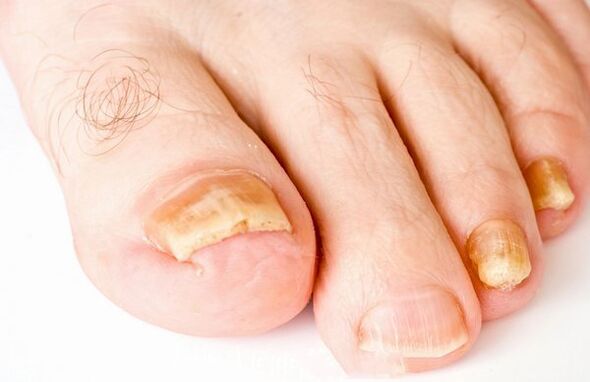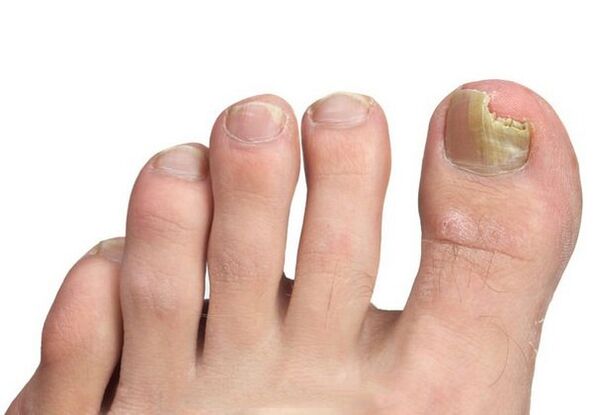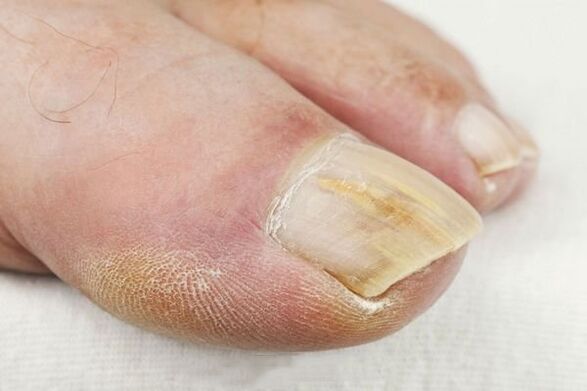Hello, dear reader.Onychomycosis is a medical name for a very common disease, which we call nail fungus.Recently, a jump in the incidence of this disease has been observed.This unpleasant fact has to do with the popularity of cheap shoes, which is not of particular quality.It is made of low-grade materials and has a low throughput of air, thus preventing normal ventilation of the feet.In this case, as the feet sweat, ideal conditions are created for the production activity of pathogenic bacteria.This problem is very common.Its scope is so large that the number of cases exceeds 20% of all the inhabitants of the planet!
As the name suggests, nail fungi is damage to the mycelium (fungus) on the nail plate.There are many pathogenic fungi that cause this disease.
However, according to the doctor, in most cases, the nail plates on the legs are affected by skin plants.The causes of disease development are much less likely to be caused by yeast (candidiasis) and mold fungi.
Sometimes in practice, you have to deal with the deformation of your nails on your legs in the black nature.
Symptoms of Nail Fungus - First Sign
Fungal damage can not only affect the nails, but also the feet.The symptoms of infection vary according to the type of pathogen that causes the disease to develop.The degree of damage to the nail plate also has value.
However, despite existing differences, general signs of fungal activity can be distinguished:
- Change the color of your nails.
- Spots, stripes, thickening, pouring in on the nail plate.
- Loosen the structure of the nails or their stratification.
- Redness, peeling, rupture of the skin of the feet.
- Itching, pain (only when walking), burning in the injury area.
- Inflammation, dryness in the affected areas of the skin.
- The feet usually exude a repulsive scent.
White patches can be observed under the feet.The peeling of the skin is replaced by the appearance of dead skin patches that cover the surface.
Types of fungal lesions
The normal nutritional form of impairment.White or pale yellow spots or strips appear on the nails.As the disease progresses, they gradually spread, gradually changing the color of the entire plate.
The thickness and the gloss on its surface remain unchanged.It may be a violation of the integration of nails with submarine fabric, which is why it exfoliates and can be removed easily and painlessly.

Hypertrophic disease form.The affected nails turn brown or gray.Thickening of the nail plate was observed due to the growth of the seabed epithelium.The nail plate itself became bread crumbs.
The side members are particularly damaged, thus obtaining a claw-like shape.This is a characteristic sign of the disease.The nail surface becomes dull.When walking, a patient suffers.
The form of atrophy damage. The nail plate changes color and turns brown and gray, losing its transparency and shine.The nails begin to collapse gradually, starting from the outside of the nail growth belt.
Growing epithelial granules are filled with loose mass.If there is no treatment, complete nail loss will occur.
Pathogen classification
Skin plant lesions.It happens in the vast majority of cases (about 90%).There are several varieties.In some people, infection can be applied to the interface area on the feet, the legs and even the skin of the hands.
Yeast failed.This breed can be difficult to identify, especially in the initial stages.The nail roller is affected first, it inflamed and swells.Later, stripping in this area is obvious, and possible itching and soreness are possible.Nails become nodules, lose their luster and will collapse.In late stages, suppurative discharge occurs.
planeal failed.Under the influence of the mold, the nails will change, obtain a green, blue hue or start to turn black.
Its side parts become rough.Over time, the affected areas die, which is why nails are deformed.Gradually, he will collapse.
Planeal failure is very rare, mainly a different form of fungal lesions and complications of HIV infection.
Classification by location of the lesion
Fungal damage can be located in different parts of the nail.In this regard, there are several types of damage in the international classification.
- Total when the fungus effect covers the entire nail.
- Distant, if only the upper part of the nail (free edge) is injured.
- Proximal end, where the nail roller is damaged (lower part of the nail plate).
- Lateral, observed on the side of the nail.
They are usually characteristic of different stages of the disease.
Lesions of foot fungus
There are several fungal damage to the feet.
Interdalz form. The most common type of foot fungus.As the name suggests, the disease affects the gap between the two substances and can later be switched to other parts of the feet, including nails.
In the digital folds, wet cracks and specific skin layers appear first.Later, skin erosion was obvious.The disease tends to develop chronic.Often complicated by streptococci infection
High pressure (scale) form.Touch the entire foot.It differs in the profound failure of the organization.At first, the skin peels off and blushs slightly, then becomes rough and eager, on high heels, sometimes cracking deep in the keratinous layer.
The disease can spread to the nails while thickening, darkening and starting to paint.The disease is a characteristic of athletes.
dyshidrotic (vesicle) form. Small vesicles (bubbles with liquid) appear on the feet, leaving traces of erosion after breaking through.The skin becomes ulcerated and the peeling area is covered with the purulent crust.It is usually accompanied by an allergic rash (due to the effects of toxins).
The disease is rare and easy to treat.But the danger here lies in the high possibility of bacterial or viral lesions, which significantly complicates the course of the disease and actually rule out the possibility of rapid recovery.
Erased form.Identification is not easy because the changes in the skin and condition of the nails are weak.The nail plate can turn a pale yellow color.The skin on the soles is slightly peeled and becomes loose.Itching can be observed.This disease is well cured.
Nail fungus - reasons for appearance
Symptoms and first signs of nail fungus suggest general levels of immune resistance in the body and improper care of the feet.

If the protection function is normal, the disease will not develop even if it is infected.The immune mechanism will deal with the invaders on its own.
However, when the development of a disease with favorable causes of immunity and related causes is weakened, the body will not be able to resist fungi.
To fight effectively, you need to try to eliminate or at least minimize the effects of these factors (e.g., unlikely to completely overcome chronic disease).
Reasons for fungi development:
- Excessive sweating in the legs.
- Violate natural ventilation of the feet (dense shoes made of low-quality materials, synthetic socks).
- Reduce body protection function.
- Violation of skin protective layer (overhygiene, overtreatment with antibacterial agents, misuse of liquids to relieve varnish).
- The nail plate is injured and damaged the soles of the legs (cracks, corn, etc.).
- The characteristics of the foot make it worse inflated (due to flat feet, obesity, etc.).
- Accompanied diseases (diabetes, varicose veins, psoriasis, metabolic diseases, digestion, blood circulation in the legs, HIV).
- Antibiotics and some other drugs that have been introduced for a long time.
- Low levels of hygiene.
- Age and sexual standards (men and older people are more susceptible to disease).
- A professional factor (with high temperature and humidity, dust, ionizing radiation, conditions for wearing rubber shoes; masseurs, orthopedics, nursing home workers, steamers, etc.) is also often sick.
- Visit the public sauna, bathroom, swimming pool.
- Salon pedicure violates the principles of hygiene and infertility.
- Family factors (total use of towels, slippers, mats in the bathroom, etc.).
As the study shows, people with diabetes are most affected by foot and nail fungi.This disease is observed in 35% of patients with diabetes.
The possibility of fungal damage to psoriasis is also high.Here, the probability is increased by 55%.
Consequences of fungal lesions

Although foot fungus does not directly threaten the lives of patients, you cannot be irrelevant to health and let everything go.
Fungal damage is not an annoying trouble at all, nor is it an unusual aesthetic problem.
Timely inconsistency in the disease leads to the development of conventionally aggravated forms of chronic disease.
Surprising complications are also possible.
- Violate the nail growth process and grow into soft tissue.
- Complete or partial loss of nails.
- Stagnation, including lymphadensis.
- Diseases are distributed to neighboring areas and deeply organized.
- Connect other infections (bacteria, viruses and fungi).
- Elevated inflammation is an acute inflammatory infectious disease.
- Diabetic foot in diabetic patients is an anatomical change that leads to increased likelihood of tissue injury, infection, suppuration and necrosis (necrosis).
- Episodes are pathological growth of skin and subcutaneous tissues, resulting in increased organ size.
- eczema.
Nail fungus treatment - cheap and effective medicine
To prescribe the correct treatment plan, you need to have an accurate diagnosis.To this end, many laboratory tests were performed.Modern pharmacology offers many different antifungal drugs.
This is why independent treatment is difficult and often proves ineffective.Doctors will have to find the pathogen, ignore the extent of the disease, damage the area, and accompany the existence of the disease.
Only when the information received is complicated can he prescribe treatment plans.Here, two topical medications (for external applications - ointments, creams, varnishes, foams, serums) and general internals (tablets, capsules).
The active substances in antifungal ointments can be cyclodermatitis, naphthalene type, Nystatin.
If the fungus has a very widespread lesions, it is recommended to use tablet anti-glia drugs.
Unlike external funds, tablets have general effects on the patient's entire body.
Pure prescription drugs based on substances such as terbinafin, fluconazole, and itraconazole.Surgical removal of the formation is usually required, but nail fungi have cheap and effective drugs.

Many of these funds are also used for preventive use.
It must be remembered that all antibacterial pilates have different side effects.Therefore, the treatment, prescription and cancellation of drugs, control of the patient's condition - all of which are only in the capacity of the doctor.
Usually, the recovery process can last a long time until a year, until the affected nails are completely renewed.
During treatment, special attention should be paid to the hygiene of the legs.Damage through fungal nails, decorative varnish is not allowed.
To prevent infection from home, you cannot walk barefoot at home, only closed shoes are allowed.It is treated twice a day with antifungal agents.After using the bath, it was carefully processed.
Co-washing of items is prohibited.After healing, you need to get rid of all objects that come into contact with your feet (towels, slippers, all socks, etc.).
suggestion
- Legs should be kept clean and dry.If necessary, wash your feet once a day - more often.After that, their surfaces (including interstices) are diligently drying.Now, you just need to wear fresh socks.
- Shoes should be comfortable from breathable materials and not too old (no more than 3 years).Bad or stylish rubber models cannot be worn every day.At the very least, the wear duration during the day should be limited.For this purpose, it is recommended to use a replaceable pair.It is highly recommended to use other people's shoes, including slippers.
- Socks are used in cotton, wool or other non-intensive materials.Only in some cases can only be worn synthetic materials.
- The most difficult thing is to eliminate fungi on wooden surfaces.This should be taken into account when visiting public ships, bathrooms, swimming pools.It is best to wear closed rubber shoes.
- Socks, guest rooms, and insoles need to be arranged regularly.
- The procedure for pedicure in salons should be performed by a certified supervisor who complies with the rules of infertility.Or follow the same principles at home.It is necessary to avoid damage to various nail plates in various ways possible, eliminate problems on the sole surface (cold forms, corn, cracks) in a timely manner, and do not abuse pedicures, degreasing and disinfectants.
Take good care of yourself and follow your health.Stay healthy!
















